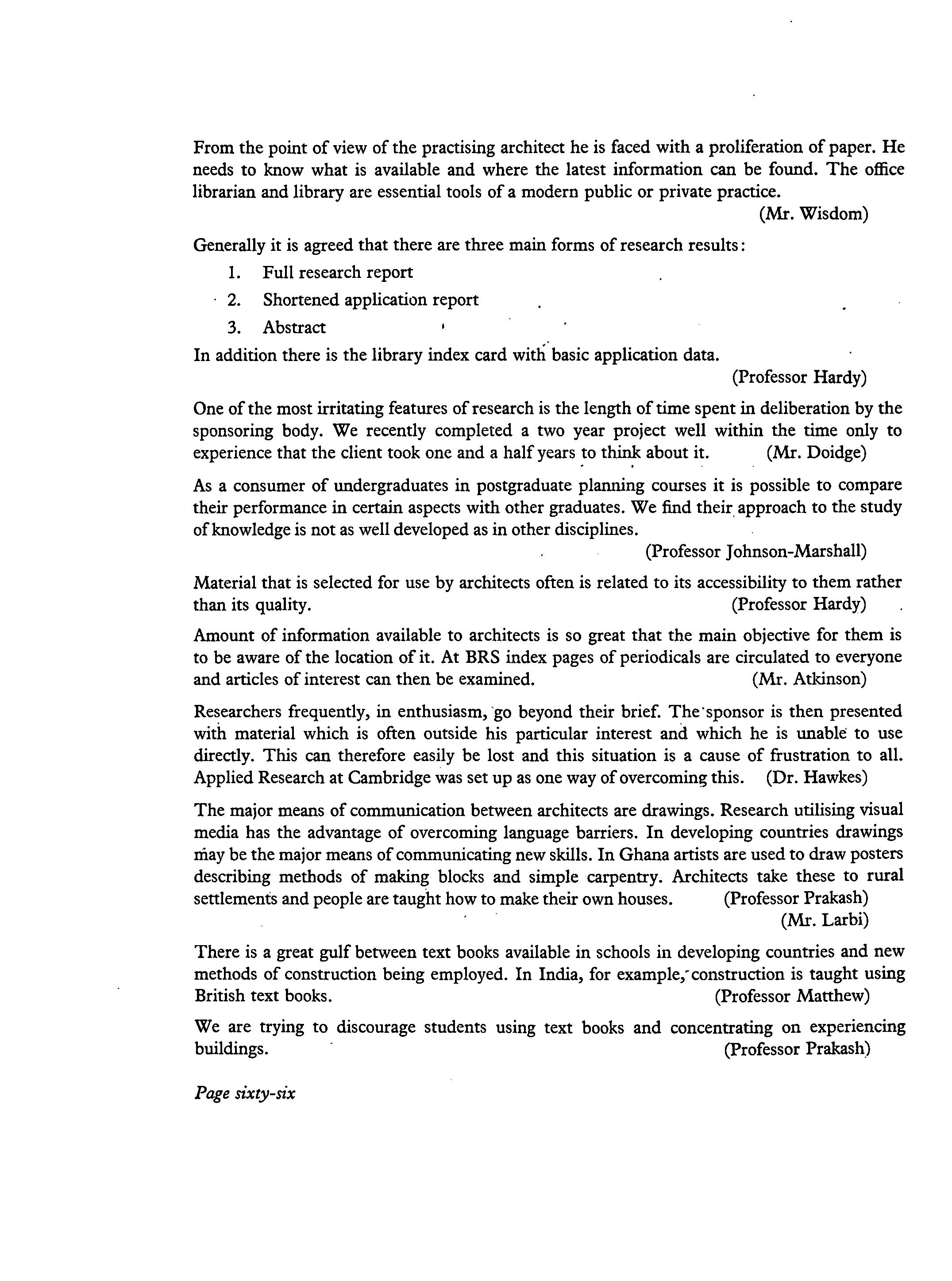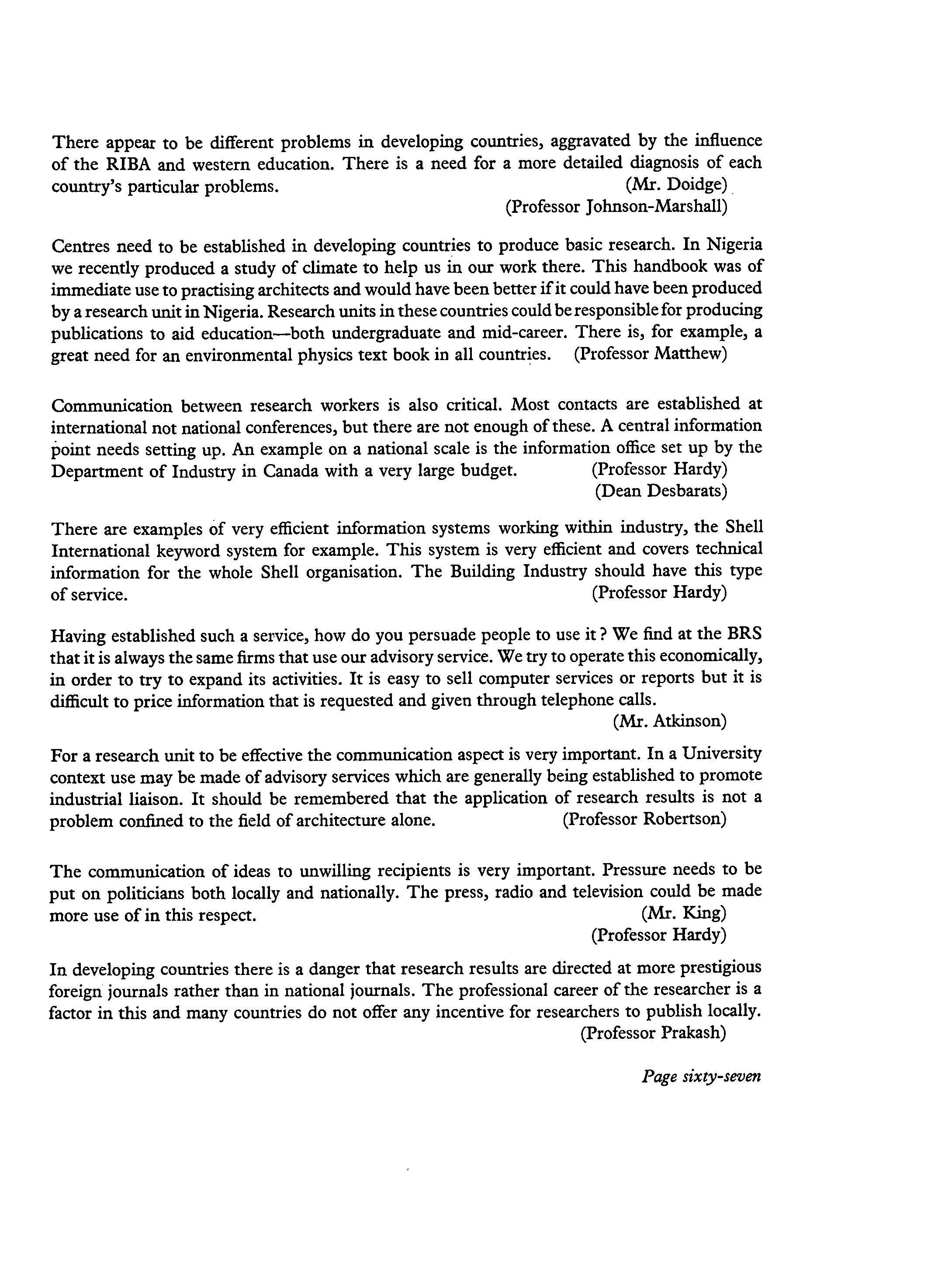
4 minute read
Session 8: Organisation and Finance
From the point of view of the practising architect he is faced with a proliferation of paper. He needs to know what is available and where the latest information can be found. The office librarian and library are essential tools of a modern public or private practice. (Mr. Wisdom)
Generally it is agreed that there are three main forms of research results: 1. Full research report • 2. Shortened application report 3. Abstract In addition there is the library index card with basic application data.
Advertisement
(Professor Hardy) One of the most irritating features of research is the length of time spent in deliberation by the sponsoring body. We recently completed a two year project well within the time only to experience that the client took one and a half years to think about it. (Mr. Doidge) As a consumer of undergraduates in postgraduate planning courses it is possible to compare their performance in certain aspects with other graduates. We find their, approach to the study of knowledge is not as well developed as in other disciplines.
(Professor Johnson-Marshall) Material that is selected for use by architects often is related to its accessibility to them rather than its quality. (Professor Hardy) Amount of information available to architects is so great that the main objective for them is to be aware of the location of it. At BRS index pages of periodicals are circulated to everyone and articles of interest can then be examined. (Mr. Atkinson) Researchers frequently, in enthusiasm, 'go beyond their brief. The sponsor is then presented with material which is often outside his particular interest and which he is unable to use directly. This can therefore easily be lost and this situation is a cause of frustration to all. Applied Research at Cambridge was set up as one way of overcoming this. (Dr. Hawkes) The major means of communication between architects are drawings. Research utilising visual media has the advantage of overcoming language barriers. In developing countries drawings may be the major means of communicating new skills. In Ghana artists are used to draw posters describing methods of making blocks and simple carpentry. Architects take these to rural settlements and people are taught how to make their own houses. (Professor Prakash) (Mr. Larbi) There is a great gulf between text books available in schools in developing countries and new methods of construction being employed. In India, for example; construction is taught using British text books. (Professor Matthew) We are trying to discourage students using text books and concentrating on experiencing buildings. ' (Professor Prakash)
Page sixty-six
There appear to be different problems in developing countries, aggravated by the influence of the RIBA and western education. There is a need for a more detailed diagnosis of each country's particular problems. (Mr. Doidge) (Professor Johnson-Marshall)
Centres need to be established in developing countries to produce basic research. In Nigeria we recently produced a study of climate to help us in our work there. This handbook was of immediate use to practising architects and would have been better if it could have been produced by a research unit in Nigeria. Research units in these countries could be responsible for producing publications to aid education—both undergraduate and mid-career. There is, for example, a great need for an environmental physics text book in all countries. (Professor Matthew)
Communication between research workers is also critical. Most contacts are established at international not national conferences, but there are not enough of these. A central information point needs setting up. An example on a national scale is the information office set up by the Department of Industry in Canada with a very large budget. (Professor Hardy) (Dean Desbarats) There are examples of very efficient information systems working within industry, the Shell International keyword system for example. This system is very efficient and covers technical information for the whole Shell organisation. The Building Industry should have this type of service. (Professor Hardy)
Having established such a service, how do you persuade people to use it? We find at the BRS that it is always the same firms that use our advisory service. We try to operate this economically, in order to try to expand its activities. It is easy to sell computer services or reports but it is difficult to price information that is requested and given through telephone calls. (Mr. Atkinson) For a research unit to be effective the communication aspect is very important. In a University context use may be made of advisory services which are generally being established to promote industrial liaison. It should be remembered that the application of research results is not a problem confined to the field of architecture alone. (Professor Robertson)

The communication of ideas to unwilling recipients is very important. Pressure needs to be put on politicians both locally and nationally. The press, radio and television could be made more use of in this respect. (Mr. King) (Professor Hardy) In developing countries there is a danger that research results are directed at more prestigious foreign journals rather than in national journals. The professional career of the researcher is a factor in this and many countries do not offer any incentive for researchers to publish locally. (Professor Prakash)
Page sixty-seven










